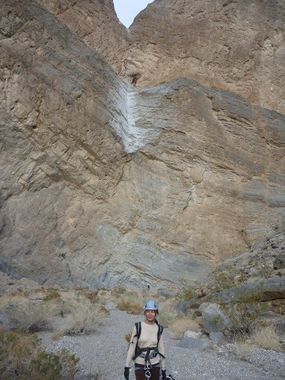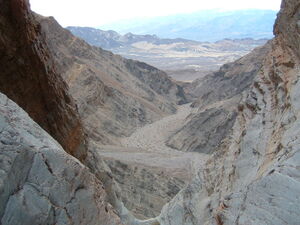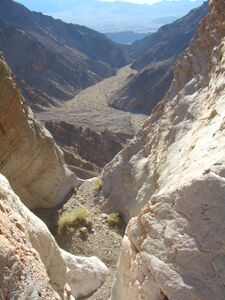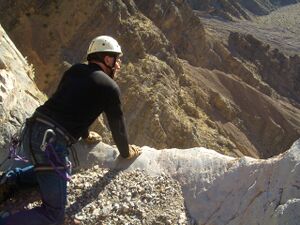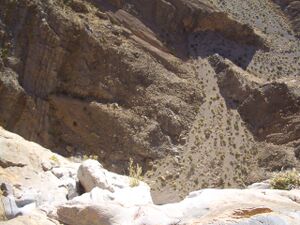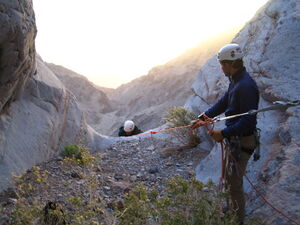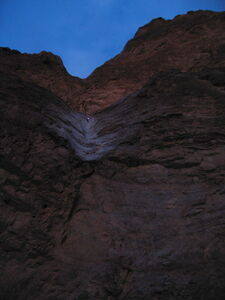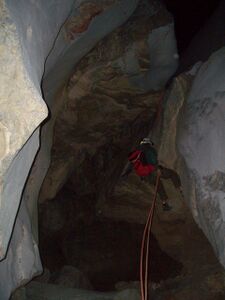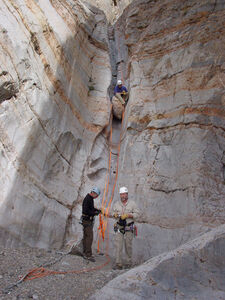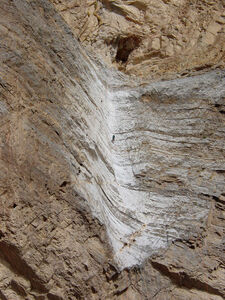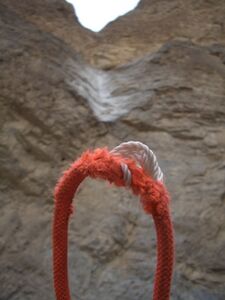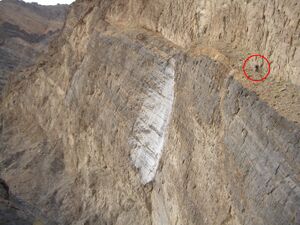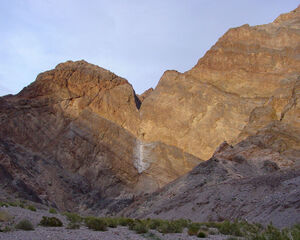Undertaker Canyon
| Rating: | |||||||||||||||||||||||||||||||
|---|---|---|---|---|---|---|---|---|---|---|---|---|---|---|---|---|---|---|---|---|---|---|---|---|---|---|---|---|---|---|---|
| | Difficulty:4A IV (v4a1 IV) Raps:3-5, max ↨580ft
Red Tape:No permit required Shuttle:Optional 2 miles Vehicle:High Clearance Rock type:Limestone (mostly) | ||||||||||||||||||||||||||||||
| Location: | |||||||||||||||||||||||||||||||
| Condition Reports: | 19 Mar 2023
"A very long desert hike with a 580-foot rappel, a beautiful narrows section, and a fun boulder jungle gym exit.. Widowmaker itself took our group |
||||||||||||||||||||||||||||||
| Best season: | Oct-Mar
|
||||||||||||||||||||||||||||||
| Regions: | |||||||||||||||||||||||||||||||
Introduction[edit]
580-foot "Widowmaker" rappel, plus a nice (but short) section of pretty limestone narrows.
The price you pay is a LONG hike up and down in washes.
The first two descents (2005/2006) were done with a car shuttle driving up Echo Canyon and starting the hike from Inyo Mine (36.49331, -116.70382), which presents an alternate approach option.
Approach[edit]
Hole-in-the-Wall Road. As of March 2023, the road is easily driven by high clearance vehicles to the end of the road, no 4x4 needed. However, the road isn't always graded past the Hole, so this could change with flash floods.
With two high-clearance vehicles, you can park one just after the Hole, and drive the other to the end of the road. Start hiking up the broad wash . . . hike for miles, eventually veering to the left. The entire hike to the saddle is a gentle wash.
From saddle, easy walk down into wash and downhill (for a long time) until the canyon narrows up.
Descent[edit]
Downclimb: about 7 feet, good for partner assist
Rap 1: Drops about 50-60 feet from two hexes placed in crack on left wall. Pretty, fluted rappel. You can see the top of Widowmaker from top of rap 1. You should be able to see the large rocks that are Widowmaker's anchor. If not, farm rocks before going down rap 1.
Rap 2 (Widowmaker): Approximately 580 feet. A large square rock (farmed previously by Mike Cressman) makes a solid, dependable anchor. With the webbing extended to the edge, it's not that bad to get over to start the rappel because there's a foot/knee hold on the other side. Might consider a courtesy shortening of webbing for all but the last person. Rappel is against vertical wall, then free hanging for at least 100 feet. Then down a polished limestone slope, then the final free hang (at least 150 feet). Other groups have talked about concerns about sharp edges, but we didn't see anything too concerning. We did adjust the rope's wear point after each rappeler.
Long wash walk.
Canyon slots up into a beautiful curvy limestone narrows that had one easy downclimb.
Canyon opens up again.
Final exit sequence is a fun boulder jungle gym. All can be climbed or partner assisted, except for final drop.
Rap 3: About 30 feet - can be done as simul-rappel over a boulder.
Exit[edit]
Follow the alluvial fan's natural gradient to a wash, which leads to your exit vehicle at the Hole-in-the-Wall.
Red tape[edit]
Roadside camping on Hole-in-the-Wall requires a permit. Permits are free but must be acquired in person at the visitor center. Advance reservations are not possible.
Bolting is not permitted in Death Valley National Park. The installation of new climbing bolts is prohibited without the written approval of the superintendent; however if existing hardware is unsafe it may be replaced. Death Valley National Park Superintendent's Compendium
Beta sites[edit]
 Super Amazing Map : Undertaker Canyon
Super Amazing Map : Undertaker Canyon
Trip reports and media[edit]
2009-03-29 explored by Scott Swaney (and teammates - see Trip Report below):
2009-03-29 https://www.facebook.com/media/set/?set=a.10162135776932930&type=3
2010-02-21 https://www.facebook.com/scott.swaney/media_set?set=a.350661922929.193792.668617929&type=3
Background[edit]
2002-01 Bob Greer identified Widowmaker dry falls (date approximate, this image may have come from the old yahoo group)
2005-11-26 A Thanksgiving group of about 16 with some canyoneers and kids planned to car shuttle a hike down the non-technical Slit Canyon, one drainage west of Undertaker Canyon. Armed with only two harnesses, a bit of webbing and some rope, the misdrawn paper topographical map led the group to the top of Widowmaker instead. Randi Gayle, Ira Lewis, Scott Smith, Jed Matthews, Doug Noel, and others including some kids retreated to the upper shuttle vehicle after Ira and Doug peered over the lip of the big drop.
2005-11-27 First known descent by Scott Smith, Jed Matthews and Ira Lewis
2006-02-04 Second descent by Ira Lewis, Mark Duttweiler, Suzanne Tanaka, Bob Anderson, and Ken King. One of the rappellers had too much friction with a figure 8 and Z-rig (the original Petzl Pirana was the primary modified 8 during that era). Bouncing caused by feeding rope on the final free hang generated a core shot at the sharp lip of the final chute, which was discovered by the third person down. The 4th and 5th in the party decided to rappel to a ledge above the second chute and traversed a ledge (not recommended) to an escape gully DCL, allowing the team to retrieve the rope by pulling down the several 200's tied together on the pull side. The fiddle stick wasn't introduced to the community at this time.
The first two descents of Widowmaker dry fall used webbing wrapped around pinch points on either side of a boulder jammed in the chute of the first rappel just above the top of the 580' drop.
Note: The 2006 core shot was in a 200m 9.2mm Bluewater Nylon Orange Canyon rope, which was the rope in common use during that era. Most mid-2020's era ropes have more aramid woven into the sheath for abrasion resistance and into the core for less dynamic stretch. A larger selection of descenders is also on the market for smoother descent control. These factors will help with future core shots.
Still, the wear point is sharper before the final free hang and bouncing on long rappels is never good for the sheath of ropes when there is contact with rock. As Scott mentioned, is it wise to at least change the wear point for each rappeller or add edge protection as seen in his trip reports.
2009-03-29 explored by Scott Swaney (and teammates - see Trip Report above) and populated ropewiki beta.
